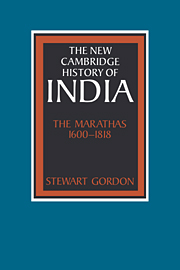Book contents
- Frontmatter
- Introduction: historiography and bibliography
- 1 The Geopolitics of Maharashtra
- 2 Marathas and the Deccan Sultanates
- 3 Shivaji (1630–80) and the Maratha polity
- 4 Responses to family invasion (1680–1719)
- 5 Baji Rao I's northern expansion (1720–1740)
- 6 Conquest to administration (1740–1760)
- 7 Centripetal forces (1760–1803)
- Index
- THE NEW CAMBRIDGE HISTORY OF INDIA
- References
6 - Conquest to administration (1740–1760)
Published online by Cambridge University Press: 28 March 2008
- Frontmatter
- Introduction: historiography and bibliography
- 1 The Geopolitics of Maharashtra
- 2 Marathas and the Deccan Sultanates
- 3 Shivaji (1630–80) and the Maratha polity
- 4 Responses to family invasion (1680–1719)
- 5 Baji Rao I's northern expansion (1720–1740)
- 6 Conquest to administration (1740–1760)
- 7 Centripetal forces (1760–1803)
- Index
- THE NEW CAMBRIDGE HISTORY OF INDIA
- References
Summary
After the death of Bajirao in 1740, there was a short and inconsequential scramble for the powerful office of Peshwa. Shahu, however, overrode the opposition and chose Bajirao's son, Balaji Bajirao, for the office. At the time (and currently in Maharashtra), he was known as Nana Saheb, and will be thus referred to throughout this section. He was only nineteen years old when he assumed office (recall that his father, Bajirao had been only twenty); his experience had been somewhat more in administration than accompanying his father on the yearly campaigns.
We shall divide the period from Nana Saheb's taking office to the watershed Battle of Panipat (1761) into two sections. First, we shall look at the expanding areas controlled by the Marathas, and there were many. Maratha leaders pushed into Rajasthan, the area around Delhi, and on into the Punjab. They attacked Bundelkund and the borders of Uttar Pradesh. Further east, the Marathas attacked Orissa and the borders of Bengal and Bihar. In the south, Maratha armies repeatedly crossed the Karnatak, collecting tribute. Second, we shall look at what sort of polity developed behind these expanding “frontiers.” Some of the themes will be the development of largely autonomous Maratha polities, problems posed by the remaining armed, elite groups in the areas conquered, and styles of factional conflict, and we will return to the theme of social mobility.
- Type
- Chapter
- Information
- The Marathas 1600–1818 , pp. 132 - 153Publisher: Cambridge University PressPrint publication year: 1993

